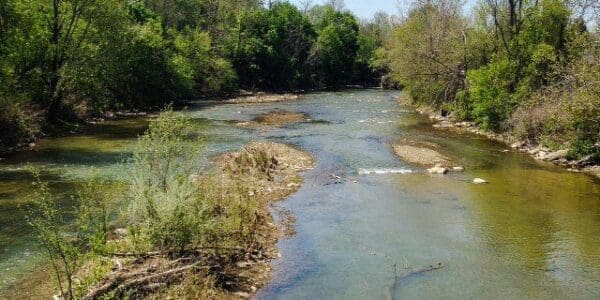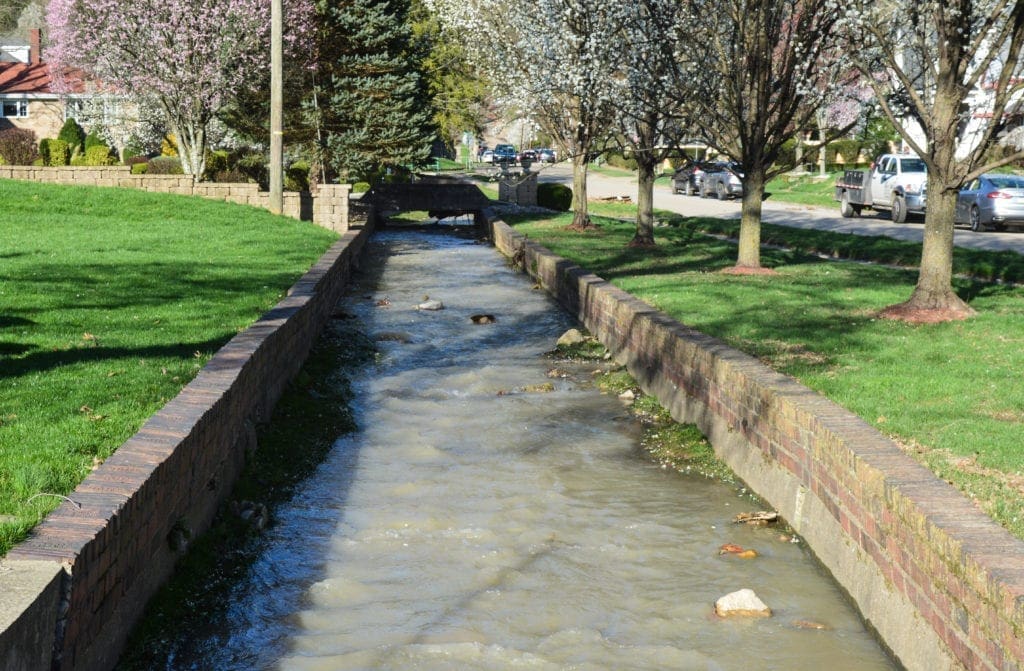The majority of the waterways in Ohio County flow with a slight trickle, but when the area has endured an extended downpour of rainfall, those creeks and streams have overflowed, wreaked havoc, and have proved fatal.
That is why the employees of the Wheeling-Ohio County Emergency Management Agency keep a close watch on those waterways and also why an ongoing conversation has taken place between the EMA and representatives of the state’s Conservation Agency. Both agencies must work with the state Department of Environmental Protection and the federal EPA so the clearing of debris and dredging can take place to mitigate issues like culvert clogging and flash flooding.
“I believe dredging always helps when it comes to our creeks and streams because we see the amount of flooding we have in certain areas,” explained Lou Vargo, director of the Ohio County EMA. “One of the big things we work on with the West Virginia Conservation Agency is getting the debris and other obstructions out of those waterways. That kind of debris is a very big problem.
“But yes, dredging always helps, and we have seen that be the case,” he said. “An example is Elm Run in Woodsdale. A lot of sediment was removed, and it helped a lot, but now that we have had some pretty significant rains this summer, Elm Run has started to fill back up, so we are keeping a close eye on it for those residents.”

The Permit Process
Over the past 25 years a plethora of federal and state regulations have been added to protect us from the pollution that took place nationwide along and in creeks and streams for many decades during the country’s industrial revolution.
That is why the common practice of dredging Big Wheeling Creek and other waterways in Ohio County vanished.
“The problem with dredging is that there are so many permits that Soil Conservation has to obtain before anything can be done,” Vargo said. “It takes a while because of the concerns over the environmental impact, but it is a process that we have navigated before, and we will again when we feel it is absolutely necessary.
“Over the years, we have learned a lot about our environment and what’s good for it and what is bad for it,” he continued. “So, many new regulations have been put into place before anything can be done in those creeks and streams. That is why it is so important to contact the right agencies and to work with people who understand the areas that are in need of the dredging.”
Vargo wished to remind residents who live along the county’s creeks and streams that they can help themselves and those living downstream.
“Another thing that really helps us avoid the flash flooding in certain areas is for the residents who live along those waterways to keep their properties clear of anything that can be swept away when the water does reach over its banks,” Vargo said. “That’s because, when we do have flooding, we have the natural debris, but we also see a lot of tires and washing machines and things like that.
“Those kinds of things lead to clogged culverts, and that slows down the run-off tremendously,” he continued. “The folks who live along the creeks and streams can really help by keeping their properties clean of anything that can float away.”

On the Radar?
The worst flooding that last took place throughout Ohio County was on Sept. 17, 2004, after 10 inches of rain fell in 10 hours. On that day, every single creek and stream flooded, and a few days later, so did the Ohio River.
FEMA was here, and the Red Cross was everywhere because, in some cases, creeks and the river flowed into and through homes throughout Ohio, Belmont, and Marshall counties. Automobiles floated away, and so did swing sets, picnic benches, and bicycles. It was a natural disaster that closed businesses, destroyed homes, and forced the evacuation of students from all schools in the Upper Ohio Valley.
“The areas in the county where we seem to have the biggest problems are along the smaller runs that travel right next to roadways,” Vargo said. “Those little streams are usually nothing but a trickle, but that quickly changes when we get one of those long downpours like we have seen the past few years. Those extended rainfalls have caused a lot of problems for a lot of people.
“For the most part, the creeks that we have in the area are OK. There are some debris issues in some areas, but the creeks appear to be in decent shape right now,” he explained. “But those runs or streams will need to be addressed soon because of the damage they can cause when we get those torrential storms.”
But will it occur, and if so, when?
“There are a lot of things that have been put on the back burner because of the pandemic, and that’s why so much has had to be delayed,” Vargo said. “I work with Ed Martin with Soil Conservation, and he’s a great guy who understands what we are dealing with in this area, so once his agency gets caught up with the inspections, we’ll be able to move forward.
“Ed has always been willing to come here and speak with residents about their concerns, so I’m sure that will take place again soon,” he added. “But again, it’s a lengthy process with a lot of steps involved, but it is something that we will do once we secure the funding for the projects we believe are necessary at this time.”


